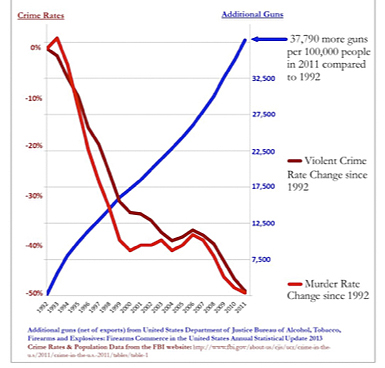
- Articles
An editorial critique of the study, “Firearm Ownership and Violent Crime in the U.S.—An Ecologic Study”
Ecologic studies are notorious for inherent errors of methodology, confounding variables, and magnifying other sample biases intrinsic to fault-prone, population-based epidemiological studies. But in the paper, “Firearm Ownership and Violent Crime in the U.S.—An Ecologic Study,” recently published in the American Journal of Preventive Medicine,[1] we find additional problems resulting from the well known proclivity of many public health researchers of using preordained, result-oriented research to push for their personal views favoring gun control and militating for disarming law-abiding citizens, purportedly to reduce gun crime perpetrated by the not-so-law-abiding felons and career criminals who, as a matter of course, ignore and flaunt the law.[2-4]
From the outset the article reveals the authors’ biases. The study begins by listing the frightening statistics of gun homicides in the U.S. with the usual obligatory comparison with other “industrialized nations (mostly Europe),” neglecting world demographics, migrations, socioeconomics, history and geography, which brings to mind our next door neighbor Mexico, as well as Brazil and most of the Western hemisphere, not to mention far away Russia and much of the world.[5-6] The discussion proceeds with another obligatory phraseology, “firearm availability and violent crime.” Considering history and geopolitics, it may be worth mentioning that what has been termed “America’s gun culture” may have contributed in part to the liberation of Europeans from the Nazis during World War II and subsequently for decades protected all of indulgent and effete Western Europe from the menacing Soviet Red Army and the threat of the T-54/55 Soviet tanks rolling and over-running the European landscape during the cold war.[7-9]
To the authors’ credit a minor effort was made to “capture data” on demographics and socioeconomics but the information is lost in the cocktail of bewilderingly complex analytical techniques and large data sets created by these ecological concoctions.[10–11] But in reality firearms and violence are the sole issues under discussion; no other societal causes are remotely considered for the endemic violence in the U.S., such as the decline in educational level, the influence of the popular culture, TV violence, increasing rates of single parenthood and broken families, drug trafficking and gang-related violence, permissive criminal justice system, the state of dependency and alienation fostered by the welfare state — a veritable cultural regression perpetuating immorality and violence[12] that journalist Cal Thomas wrote in a recent column is morally “rotting from within.”[13]
In this study, though, homicides and guns are the ultimate bogeymen, but no distinction is made to separate criminal homicides from justifiable gun homicides or self-defense shootings. And no significant effort was made to delineate the beneficial aspects (preventive or defensive uses) of gun ownership in incidents involving assaults, robberies, and homicides — i.e., the very topics supposedly of interest to the researchers. Nevertheless, the authors purportedly reached alarming conclusions —namely that states with higher levels of gun ownership have an increased risk for assaults and robberies perpetrated with firearms.[1]

Although the flaws of the ecologic methodology are evident, the omissions are even more damaging to the study. The seminal work in these areas conducted and published by researcher John Lott is not cited or even mentioned.[3] And one can not see the forest for the trees: The fact is that while Americans continue to purchase and possess more private firearms than ever in our history, rates of homicide and violent crimes have been steadily diminishing for several decades because more guns, at least in the hands of the law‑abiding citizens, do not translate into more crime.[3-4] The number of private firearms has in fact increased from approximately 200 million in 1995 to 300 million in 2012, with a concomitant decrease in both homicides and violent crimes since 1992 to the present.[12,14] Moreover, as shown by the work of John Lott, Gary Kleck, and others, firearms in the hands of law-abiding citizens actually decrease crime. There is considerable historical evidence that gun ownership in the hands of citizens also protects their property and their freedom.[7-9] The problem with endemic crime is not which states have the most guns but with irresponsible gun ownership and the proportion of guns in the hands of criminal elements.[12] Despite laws to the effect, we as a society have not kept guns from falling into the wrong hands because of our broken criminal justice and mental health systems, not to mention an overall deteriorating moral value system, which is obvious to anyone who cares to reflect and evaluate our descent in cultural devolution.[12-13]
This study is subject to similar flaws as those repeatedly found in much of the public health literature dealing with guns and violence, including one study I personally analyzed more than a decade ago in which researcher Hemenway was also one of the authors.[15-16] No significant effort was made to address some of the objections many of us have made regarding bias and politicization of gun research in public health methodology. Consequently, we should not be surprised that Congress in 1997 after carefully studying the issue defunded and thereafter wisely refused to resume funding “gun research”— or rather gun control propaganda masquerading as gun violence research.[17-18] Doctors for Responsible Gun Ownership (DRGO) as well as many other independent investigators have been documenting this fact for years [19-20]; but if the question is asked about who is responsible for defunding gun research, public health apologists will answer that the NRA is solely responsible![21-22]
Independent investigators have provided Congress over the years with truck loads of evidence that much of the gun research conducted by public health researchers was junk science, biased research promulgated by the ideologically committed as well as self-serving public health officials in cahoots with the very public relations-conscious leaders of the AMA, “organized medicine,” and their publications.[11,14,16-20,23]
It should also be of interest that private researchers particularly those associated or sponsored by the pharmaceutical and chemical industries are frequently disparaged by those in public health service, as if the fiduciary association of the former immediately taints their integrity, work, and conclusions. But why is it not so the other way around, for those receiving tax money or funded by private tax-exempt foundations, such as the Joyce Foundation, with ideological axes to grind? And why do those same gun researchers decade after decade keep telling us that more studies are needed (and additional funding necessary) — militating in their own financial self-interests as well as subsidizing their ideological agendas? These are good questions whose answers may save taxpayers bundles of money and in the long term, perhaps, even their freedom!
Acknowledgement
Many thanks to Timothy W. Wheeler M.D., Director of Doctors for Responsible Gun Ownership, A Project of the Second Amendment Foundation, Upland, CA., for reading and making valuable suggestions to the manuscript. His website is: https://drgo.us/.
References
1. Monuteaux MC, Lee LK, Hemenway D, Mannix R and Fleegler EW. Firearm Ownership and Violent Crime in the U.S.—An Ecologic Study. Am J Prev Med 2015;49(2):207–214.
2. United States Bureau of Justice Statistics. Homicide trends in the U.S. Available from: http://bjs.ojp.usdoj.gov/content/homicide/race.cfm. [Last accessed July 19, 2015.]
3. Lott J. More Guns, Less Crime: Understanding Crime and Gun Control Laws. Chicago, IL: University of Chicago Press; 1998.
4. Kleck G. Targeting Guns: Firearms and Their Control. Hawthorne, NY: Aldine de Gruyter; 1997.
5. Stolinsky DC. America the most violent nation? Medical Sentinel 2000;5(6):199-201.
6. Stolinsky DC. Homicide and Suicide in America, 1900-1998. Medical Sentinel 2001;6(1):20-24.
7. Faria MA. America, guns, and freedom. Part I: A recapitulation of liberty. Surg Neurol Int 2012;3(1):133. Available from: http://surgicalneurologyint.com/surgicalint_articles/america-guns-and-freedom-part-i-a-recapitulation-of-liberty.
8. Faria MA. America, guns and freedom: Part II — An international perspective. Surg Neurol Int 2012;3(1):135. Available from: http://surgicalneurologyint.com/surgicalint_articles/america-guns-and-freedom-part-ii-an-international-perspective.
9. Faria MA. The American ‘gun culture’ that saved Europe. GOPUSA.com, February 24, 2015. Available from: https://haciendapublishing.com/the-american-gun-culture-that-saved-europe.
10. Charlton BC. Statistical malpractice. Journal of the Royal College of Physicians in London, March-April 1996, pp. 112-114.
11. Milloy SJ. Junk Science Judo. Washington, DC, Cato Institute, 2001, pp. 54-97.
12. Faria MA. Shooting rampages, mental health, and the sensationalization of violence. Surg Neurol Int 2013;4(1):16. Available from: https://surgicalneurologyint.com/surgicalint-articles/shooting-rampages-mental-health-and-the-sensationalization-of-violence.
13. Thomas C. Another signpost on the road to destruction. Townhall. April 27, 2015.
14. Orient JM. “Gun violence” as a public health issue: a physician’s response. J Am Phys Surg 2013;18:77-83.
15. Miller M, Azrael D, Hemenway D. Firearm availability and unintentional firearm deaths, suicide, and homicide among 5-14 year olds. J Trauma 2002;52(2):267-275.
16. Faria MA. Statistical Malpractice ‘Firearm Availability’ and Violence (Part II): Poverty, Education and other Socioeconomic Factors. Hacienda Publishing, Inc. March 24, 2002. Available from: https://haciendapublishing.com/statistical-malpractice-firearm-availability-and-violence-part-ii-poverty-education-and-other-socioeconomic-factors.
17. Faria MA. Gun Research 2013 — an interview with Dr. Miguel A. Faria by Rebecca Trager of Research Europe. Hacienda Publishing Inc. February 13, 2013. Available from: https://haciendapublishing.com/gun-research-2013-an-interview-with-dr-miguel-a-faria-by-rebecca-trager-of-research-europe.
18. Faria MA. Gun Research 2013 — an interview with Dr. Miguel A. Faria by Craig Schneider of Atlanta Journal Constitution. January 20, 2013. Available from: https://haciendapublishing.com/gun-research-2013-an-interview-with-dr-miguel-a-faria-by-craig-schneider-reporter-atlanta-journal-constitution.
19. Wheeler T. The history of public health gun control. DRGO. March 26, 2015.
20. Wheeler T. Private guns, public health — Hemenway is blindingly biased. The Freeman. July 12, 2010. Available from: http://fee.org/freeman/detail/private-guns-public-health.
21. Schneider C and Suggs E. CDC: Politics affected gun violence research. Atlanta Journal and Constitution. December 19, 2012. Available from: http://www.ajc.com/news/news/cdc-politics-affected-gun-violence-research/nTZnf/%20%20%20.
22. Trager R. In the line of fire. Research Europe, July 2, 2013. Available from: http://www.researchresearch.com/index.php?option=com_news&template=rr_2col&view=article&articleId=1290068.
23. Bennett JT, DiLorenzo TJ. From Pathology to Politic: Public Health in America. New Brunswick, New Jersey, Transaction Publishers, 2000.
Written by: Dr. Miguel Faria
Miguel A. Faria, Jr., M.D. is Clinical Professor of Surgery (Neurosurgery, ret.) and Adjunct Professor of Medical History (ret.) Mercer University School of Medicine. He is an Associate Editor in Chief and a World Affairs Editor of Surgical Neurology International (SNI), and an Ex-member of the Injury Research Grant Review Committee of the Centers for Disease Control and Prevention (CDC). 2002-05; Former Editor-in-Chief of the Medical Sentinel (1996-2002), Editor Emeritus, the Association of American Physicians and Surgeons (AAPS); Author, Vandals at the Gates of Medicine (1995); Medical Warrior: Fighting Corporate Socialized Medicine (1997); and Cuba in Revolution: Escape From a Lost Paradise (2002).
Edited versions of this commentary have also been published in GOPUSA.com (July 20, 2015) with the title, “Firearm ownership, violence, and public health”; on Doctors for Responsible Gun Ownership (DRGO) website and a shorter version in the Macon Telegraph (July 31, 2015).
This article can be cited as: Faria MA. An editorial critique of the study, “Firearm Ownership and Violent Crime in the U.S. — An Ecologic Study.” HaciendaPublishing.com, July 19, 2015. Available from: https://haciendapublishing.com/an-editorial-critique-of-the-study-firearm-ownership-and-violent-crime-in-the-u-s-an-ecologic-study.
Copyright ©2015 Miguel A. Faria, Jr., MD